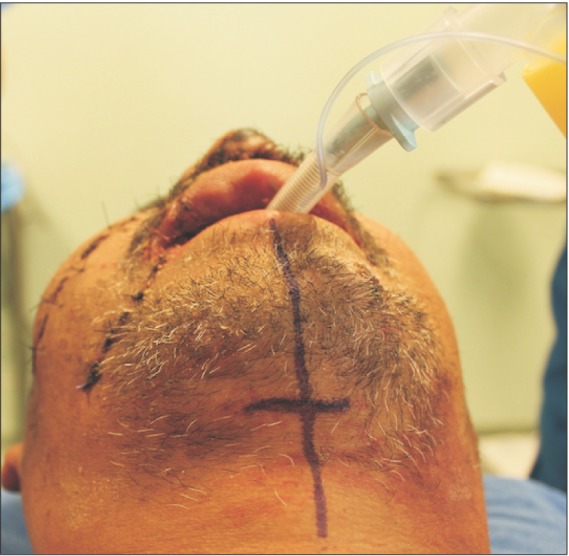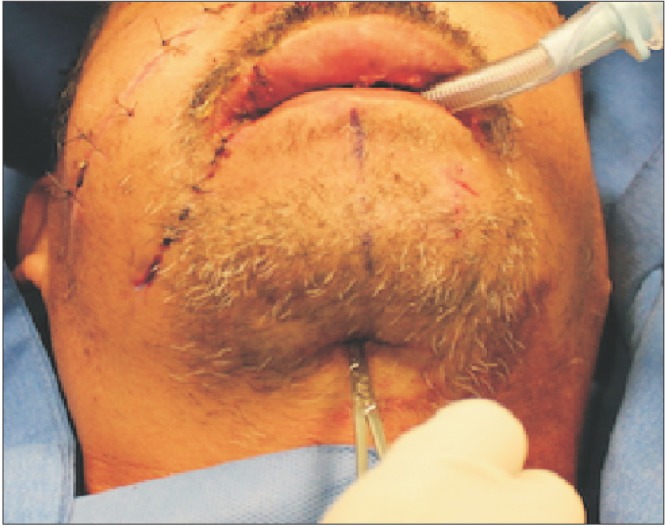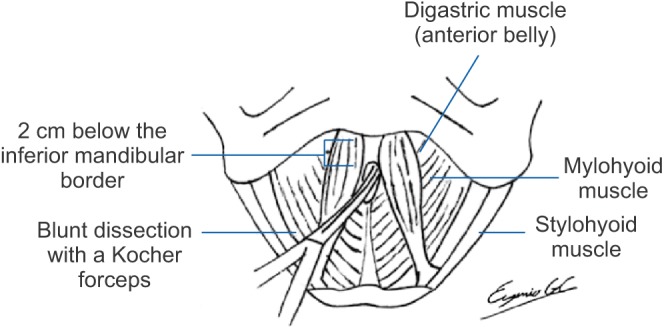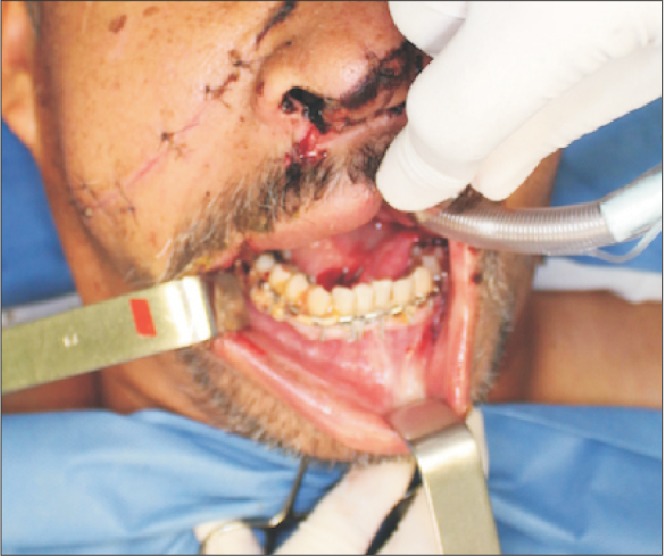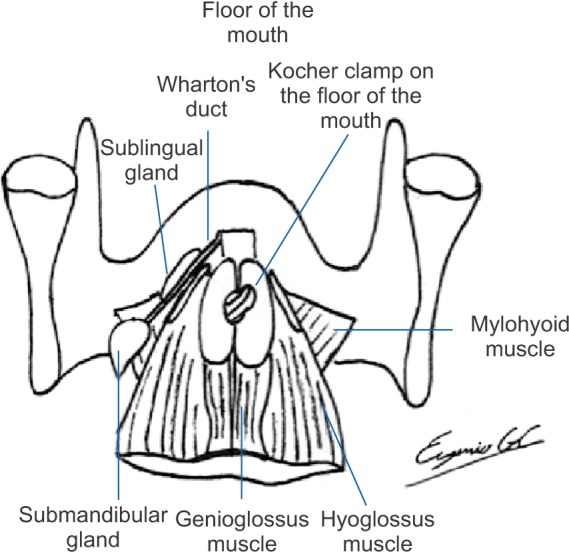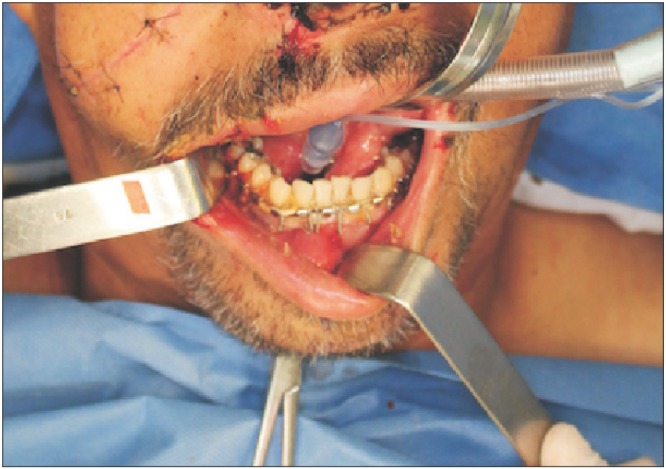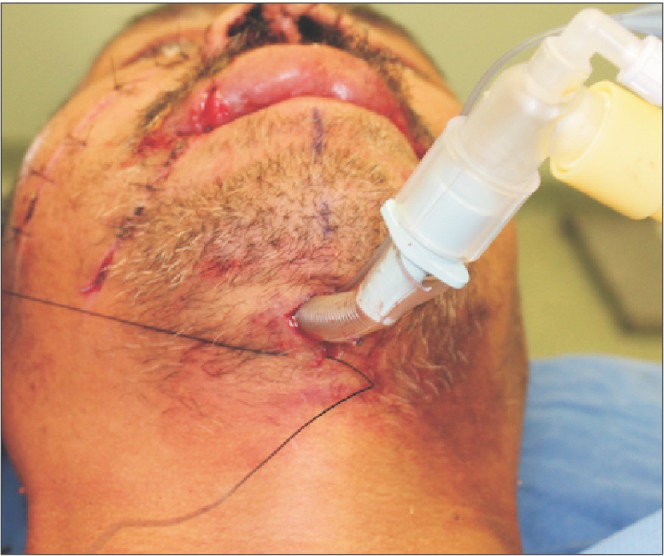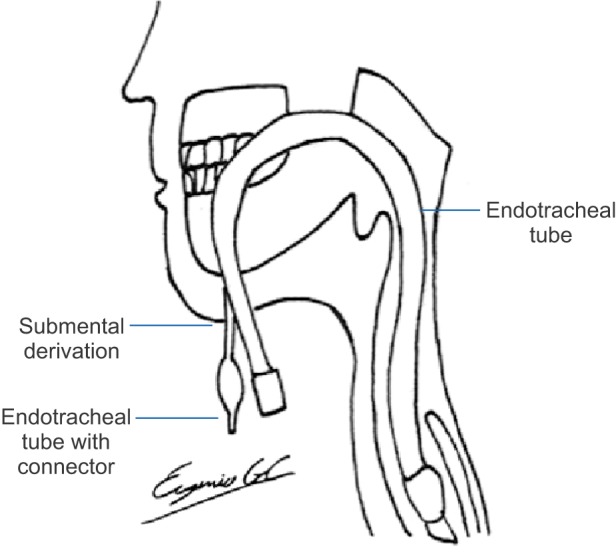J Korean Assoc Oral Maxillofac Surg.
2018 Feb;44(1):12-17. 10.5125/jkaoms.2018.44.1.12.
Airway management through submental derivation: a safe and easily reproduced alternative for patients with complex facial trauma
- Affiliations
-
- 1Department of Plastic and Reconstructive Surgery, Instituto de Seguridad Social del Estado de México y Municipios (ISSEMyM), Toluca, Mexico. eugenio_g_c@hotmail.com
- KMID: 2405371
- DOI: http://doi.org/10.5125/jkaoms.2018.44.1.12
Abstract
OBJECTIVES
Airway management in patients with panfacial trauma is complicated. In addition to involving facial lesions, such trauma compromises the airway, and the use of intermaxillary fixation makes it difficult to secure ventilation by usual approaches (nasotracheal or endotracheal intubation). Submental airway derivation is an alternative to tracheostomy and nasotracheal intubation, allowing a permeable airway with minimal complications in complex patients.
MATERIALS AND METHODS
This is a descriptive, retrospective study based on a review of medical records of all patients with facial trauma from January 2003 to May 2015. In total, 31 patients with complex factures requiring submental airway derivation were included. No complications such as bleeding, infection, vascular, glandular, or nervous lesions were presented in any of the patients.
RESULTS
The use of submental airway derivation is a simple, safe, and easy method to ensure airway management. Moreover, it allows an easier reconstruction.
CONCLUSION
Based on these results, we concluded that, if the relevant steps are followed, the use of submental intubation in the treatment of patients with complex facial trauma is a safe and effective option.
Keyword
MeSH Terms
Figure
Reference
-
1. Mohan R, Iyer R, Thaller S. Airway management in patients with facial trauma. J Craniofac Surg. 2009; 20:21–23. PMID: 19164982.
Article2. Hernández Altemir F. The submental route for endotracheal intubation. A new technique. J Maxillofac Surg. 1986; 14:64–65. PMID: 3456416.3. Arya VK, Kumar A, Makkar SS, Sharma RK. Retrograde submental intubation by pharyngeal loop technique in a patient with faciomaxillary trauma and restricted mouth opening. Anesth Analg. 2005; 100:534–537. PMID: 15673888.
Article4. Garg M, Rastogi B, Jain M, Chauhan H, Bansal V. Submental intubation in panfacial injuries: our experience. Dent Traumatol. 2010; 26:90–93. PMID: 20089066.
Article5. Amin M, Dill-Russell P, Manisali M, Lee R, Sinton I. Facial fractures and submental tracheal intubation. Anaesthesia. 2002; 57:1195–1199. PMID: 12479188.
Article6. Caubi AF, Vasconcelos BC, Vasconcellos RJ, de Morais HH, Rocha NS. Submental intubation in oral maxillofacial surgery: review of the literature and analysis of 13 cases. Med Oral Patol Oral Cir Bucal. 2008; 13:E197–E200. PMID: 18305443.7. Caron G, Paquin R, Lessard MR, Trépanier CA, Landry PE. Submental endotracheal intubation: an alternative to tracheotomy in patients with midfacial and panfacial fractures. J Trauma. 2000; 48:235–240. PMID: 10697080.
Article8. de Melo WM, Brêda MA Jr, Pereira-Santos D, Pereira CC, Sonoda CK, Araújo MM. Submental endotracheal intubation: a valuable resource for the management of panfacial fractures. J Craniofac Surg. 2012; 23:1851–1853. PMID: 23147327.9. Gadre KS, Waknis PP. Transmylohyoid/Submental intubation: review, analysis, and refinements. J Craniofac Surg. 2010; 21:516–519. PMID: 20216444.10. MacInnis E, Baig M. A modified submental approach for oral endotracheal intubation. Int J Oral Maxillofac Surg. 1999; 28:344–346. PMID: 10535533.
Article11. Paetkau DJ, Stranc MF, Ong BY. Submental orotracheal intubation for maxillofacial surgery. Anesthesiology. 2000; 92:912. PMID: 10719991.
Article12. Malhotra N, Bhardwaj N, Chari P. Submental endotracheal intubation: a useful alternative to tracheostomy. Indian J Anaesth. 2002; 46:400–402.13. Chandu A, Witherow H, Stewart A. Submental intubation in orthognathic surgery: initial experience. Br J Oral Maxillofac Surg. 2008; 46:561–563. PMID: 18584927.
Article14. Prasanna D, Bhat S. Nasotracheal intubation: an overview. J Maxillofac Oral Surg. 2014; 13:366–372. PMID: 26224998.
Article
- Full Text Links
- Actions
-
Cited
- CITED
-
- Close
- Share
- Similar articles
-
- Evaluation of safety and usefulness of submental intubation in panfacial trauma surgery
- Two Cases of Submental Endotracheal Intubation in Patients Having Multiple Facial Fractures
- Submental Intubation with Reinforced Tube for Intubating Laryngeal Mask Airway
- Submental intubation: alternative short-term airway management in maxillofacial trauma
- Submental intubation using laparoscopic trocar in zygomaticomaxillary complex fracture surgery in Korea: a case report

